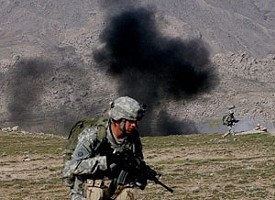
Washington University neuroscientists continue to use new technology to venture deeper into the recesses of the brain. Some of this has taken the form of mind-reading. And now, less science-fiction-y and more depressing, doctors have used a new, highly-sensitive scanner to detect traumatic brain injuries previously invisible to CT scans and MRI's. The scans show that soldiers who have received concussions from explosions may have sustained more damage than previously thought.
In a study published yesterday in the New England Journal of Medicine, doctors examined 84 U.S. soldiers who had been evacuated from Iraq and Afghanistan to Landstuhl Regional Medical Center in Germany. Using diffusion tensor imaging (DTI), an advanced form of MRI, the doctors found brain abnormalities in 18 of 63 patients who had previously been diagnosed with mild traumatic brain injuries, known to civilians as concussions. If left to chance, the doctors estimate only 2 of the 63 would have shown the same abnormalities.
"We call these injuries 'mild,' but in reality they sometimes can have serious consequences," Dr. David L. Brody, an assistant professor of neurology at the Wash. U. medical school, said in a press release.
An estimated 320,000 Americans have suffered some sort of brain trauma in Iraq and Afghanistan.
In the case of the 18 injured patients in the study, the DTI detected abnormalities in the brain's "white matter," the wiring system that nerve cells use to communicate with one another. This may explain what, exactly, causes many of the symptoms that come from mild traumatic brain injuries: headaches, disorientation, difficulties balancing, thinking and focusing the eyes. Right now, nobody's sure whether these all come from structural damage to the brain, disruptions in brain chemistry or psychological factors.
"There is still a lot more work to be done before we fully understand whether these abnormalities truly represent significant damage to the brain white matter," admitted the study's lead author, Christine L. Mac Donald, a neurologist at Wash. U. "And if so, how this damage affects attention, memory, emotional regulation, balance, coordination, sleep and other functions. Likewise, the relationship between mild traumatic brain injury and post-traumatic stress disorder is especially important. Our ongoing studies will hopefully start to answer some of these questions."
The current study, however, did show that the brains of soldiers who had been injured by blasts looked different from soldiers -- and civilians -- who had suffered other forms of head trauma. The scans also matched computer simulations of brain damage from blast injuries the doctors had done beforehand. Unfortunately, all of the patients in the study had also suffered from other head injuries, like auto crashes or being struck by blunt objects, so it was difficult to determine how much of the injuries were blast-related.
Nonetheless, the military plans to use the results of the study to redesign helmets in order to reduce damage from explosions and, using information from the future studies promised by Mac Donald, develop new treatments for post-traumatic stress disorder once doctors are able to distinguish physiological symptoms from the psychological.





